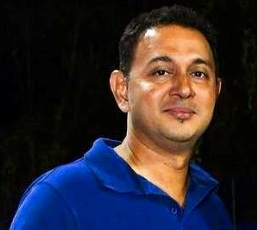
Secretary of Goa State Tennis Association Bulu Godinho
From challenges and triumphs of Goa's tennis journey to creating grassroots programs and infrastructure like tennis courts to igniting passion in aspiring young players, Bulu Godinho , secretary of the Goa State Tennis Association in conversation with Rohit Bhandiye , sheds light on the stories behind the making of Goa's tennis stars and the strategic roadmap envisioned by the Association for a brighter tomorrow for Goa’s tennis ecosystem.
Q. Regarding the infrastructure for tennis in Goa, are there enough courts in Goa? And what is the popularity like of the sport in the state?
Bulu: Initially, our access to tennis courts relied heavily on exclusive clubs like Panjim Gymkhana, Tennis de Gaspar Dias and the BPS Club in Margao, where facilities are restricted only to members. This highlighted the pressing need for improved infrastructure, a concern we consistently raised with the government. Infrastructure is crucial for tennis development. Although the government built four courts thanks to the National Games, more are needed across various locations. We now have a multipurpose ground at Fatorda thanks to the National Games which is accessible to the public, although awareness about its availability is limited. Encouraging wider participation remains a challenge, particularly as tennis is often perceived as an expensive sport, despite its affordability compared to others like cricket. Recognising this, we proposed to the government the establishment of four courts in each taluka, with at least two covered courts, across six to seven talukas. Goa's tennis development is hindered by the lack of infrastructure, underscoring the urgency for government intervention in providing suitable land and facilities.
Q. Are there any programs for grass root development of tennis in Goa?
A: Establishing a sustainable program is extremely challenging without the necessary infrastructure. Currently, clubs limit access to members only, posing a significant barrier to widespread participation. Without accessible venues, maintaining a consistent program becomes problematic. Also, travelling long distances for training isn't practical. Academic concerns and the need to earn a living also affect participation. However, once infrastructure is in place, the initiative can truly take off. This is exemplified by the recent establishment of a court in Fatorda, resulting in a notable influx of around 30 to 40 committed students attending daily. This marks a significant milestone as it opens up the opportunity for public engagement in the sport for the first time.
Q. Apart from Natasha Palha, Goa has failed to produce any tennis players of national repute. What do you think is the reason behind that?
A:That’s not true, actually. In fact, Nikunj Siwach is one of the top players at the national level and has made a huge impact and currently competes in the German League. He stands among the top-tier players, transitioning to the European leagues, a path often pursued by retired professionals. Similarly, Tejas Shevde has demonstrated notable success in various national tournaments, although he didn't solely focus on tennis. Natasha's journey has been supported significantly by Mr. Shrinivas Dempo, a crucial sponsor in a sport known for its high expenses. Natasha's parents also played a vital role, making significant sacrifices to nurture her talent. The responsibility lies with the government to identify and support promising players financially. Without funding, it's nearly impossible to nurture talent as it necessitates financial resources. Numerous emerging tennis talents, backed by supportive parents, are also making waves in the scene like Mika Sheth, Sahil Gajinkar and Vardhan Karkal. While talent abounds, recognition may be limited.
Q. Tennis is an expensive sport. How can common people pursue it?
A:Isn’t badminton an expensive sport? Shuttles come at a high cost. I recall Don Bosco opening a court and we offered free racquets and balls during a summer camp, yet there was minimal interest, with only one participant. Despite attempts to subsidise it, response was lacking. While not cheap, the main challenge was access to courts, typically requiring club membership. As infrastructure improves, accessibility increases. In Margao, the courts at Fatorda are available for affordable coaching programs in a private-government partnership. Additionally, private coaches like Deepak Nahak and Santosh Gorawar, who are affiliated with us offer reasonably priced coaching camps, contributing to the sport's growth at grassroots levels.
Q. Can you tell us more about the recently concluded Gadre Gaspar Dias Open?
A:The Gadre Gaspar Dias Open initially began as a one-off tournament, aimed at injecting fresh competition by inviting players from neighbouring states like Karnataka and Maharashtra. The tournament quickly gained attraction, attracting attention beyond state borders due to its high-quality organisation and competitive atmosphere. This year we made history with a record-breaking 479 entries for the Gadre Gaspar Dias Open, now in its ninth consecutive year. It has evolved into an all-India tournament. A tournament of this scale would not be possible without financial backing and venues. I want to thank Arjun Gadre, Managing Director of Gadre Premium Seafood, for sponsoring the tournament for nine years and the managing committees of Clube Tennis de Gaspar Dias as well Panjim Gymkhana for supporting the tennis community in Goa. Over the next three months, all Goa ranking tournaments will take place at Panjim Gymkhana, BPS Club in Margao and the multi-purpose courts in Fatorda, exclusively for Goan participants.
Q. Anything else that you would like to add?
A:Tennis is gaining popularity in Goa gradually, evident from the increasing number of players and their improved skills. Enthusiasm for the sport is growing visibly. Although we proposed inter-school tournaments, similar to other sports like basketball and badminton, it hasn't gained attraction yet due to limited interest or participation from schools. However, we remain hopeful for its implementation this year. Also, a new president is getting ready to run the association which will bring renewed enthusiasm and energy into the association.